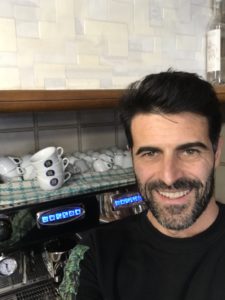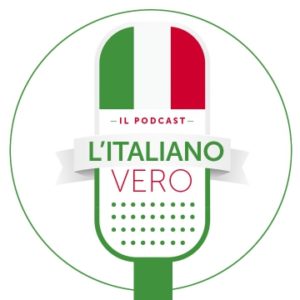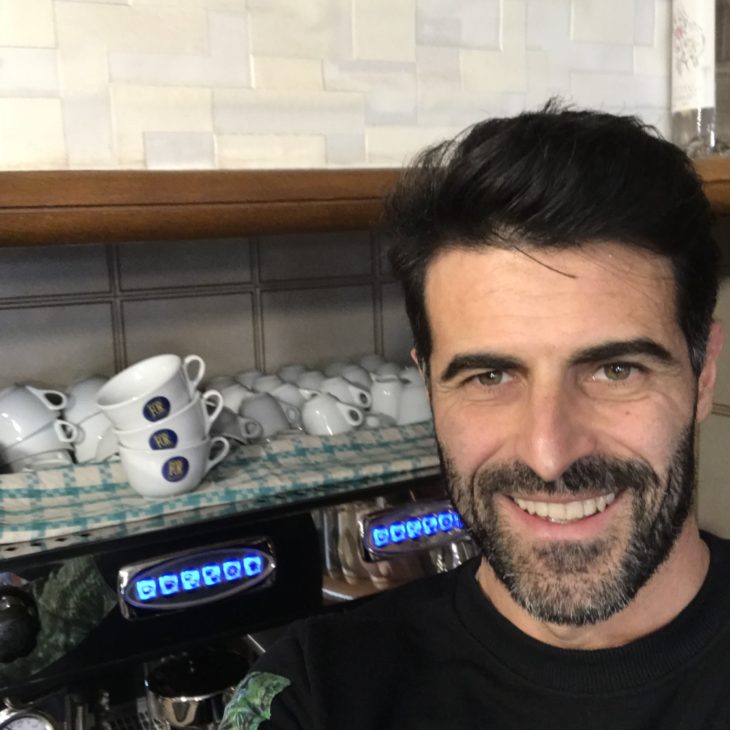
Blog in italiano
Tempo di lettura: 4 min
Trascrizione episodio disponibile: clicca <qui>
________________
Oggi parliamo di: caffè, barbiere, Tomas.
In questo episodio Massimo e Paolo ci parlano di una delle abitudini più ricorrenti di noi Italiani Veri. Il caffè. Massimo fa subito una domanda a bruciapelo (Fig., all’improvviso, prendendo alla sprovvista) a Paolo su quanti caffè beva al giorno. Scopriamo così che Paolo beve due caffè durante le giornate lavorative ma quando ha un po’ più di tempo a casa si prepara un caffè molto lungo, all’americana, veramente molto inusuale per un Italiano Vero.
Massimo invece beve il primo caffè a casa preparandolo con la classica moka (quasi un “rito” a cui non rinuncerebbe mai) e un altro appena arrivato in ufficio con i colleghi e qualche volta uno a metà mattina.
Paolo ha notato che durante il suo recente viaggio a Londra, i bar sono molto più tranquilli e la gente aspetta educatamente il proprio turno in fila, però difficilmente il caffè viene servito nella piccola tazzina di porcellana a cui un Italiano Vero non può proprio rinunciare. Massimo ricorda infatti un detto napoletano che gli ricordava suo nonno e cioè il Caffè con le tre C: Una formula vincente che sembra derivare dalla frase dialettale “Comme Cavolo Coce”, scritta sul muro dietro il Conservatorio della città di Napoli da alcuni musicisti che, seppur in ritardo, non rinunciavano ad un caffè e ad una breve chiacchierata.
Massimo durante i sui viaggi all’estero ha notato che nei bar o nelle catene come Starbucks dietro le casse c’è sempre un listino molto evidente dal quale poter scegliere facilmente cosa ordinare, mentre in quelli italiani questo listino è raramente presente. Inoltre spesso ti vengono rivolte molte domande su eventuali variazioni. Massimo infatti racconta che appena arrivato in America non comprendendo la domanda su dove volesse consumare il caffè “for here or to go” non capendo rispondeva Yes ;-)
Pertanto Massimo e Paolo si mettono nei panni di uno straniero per aiutarlo nella scelta di cosa si può’ ordinare al bar e alle eventuali domande che il barista può porre al cliente per prendere l’ordinazione.
Per fare chiarezza hanno invitato al podcast Tomas, amico di Massimo, parrucchiere/barbiere di pomeriggio ma barista alla mattina presso il Cafe’ del Sol bar che gestisce insieme alla sua compagna, sito a Ponteranica in provincia di Bergamo.
I tre chiacchierando chiariscono subito che un italiano vero per ordinare un espresso chiede semplicemente “un caffè”. Tomas fa notare che purtroppo i clienti presi dalla frenesia alle volte non chiedono per cortesia o “grazie”. Questa cosa fa venire in mente a Massimo un podcast sulla gratitudine che ha ascoltato di recente dove l’autore racconta appunto che la gratitudine porta felicità sia a chi la esprime che a chi la riceve e pertanto l’autore ha voluto dimostrarlo facendo un esperimento ringraziando tutte le persone che ci sono dietro ad una tazzina di caffè:
qui puoi trovare il suo TED Talk in proposito
e il suo libro Thank a thousand a gratitude journey
Una delle poche domande che Tomas fa al cliente è “lo vuole liscio?” e il cliente può’ rispondere :
- liscio:
- macchiato che solitamente intendiamo con aggiunta di latte caldo oppure specificando il tipo di macchiatura :
- Latte freddo
- Latte Zymil per chiedere latte senza lattosio (Zymil è il nome commerciale del latte senza lattosio della Parmalat)
- Latte di soia
- Corretto se intende aggiungere un liquore (Grappa, Sambuca, Vecchia Romagna)
Oppure è possibile ordinare:
- un classico cappuccino che nel nord Italia viene chiamato anche cappuccio.
- Il latte macchiato da non confondersi con il caffè macchiato. Il latte macchiato è un bicchiere di latte con una aggiunta di caffe. Mentre il caffè macchiato è un espresso con un po’ di latte come detto sopra.
- Un latte che è semplicemente una tazza di latte, mentre all’estero viene inteso con caffè con latte.
- Marocchino: è un prodotto relativamente nuovo che consiste in un caffè con uno strato di cacao sopra, crema di latte e ancora polvere di cacao in cima alla crema. Tomas è un vero artista nel prepararlo e usa solo la crema di latte e non semplice latte.
Con Tomas scopriamo inoltre che solitamente il caffè viene consumato al banco, ma ci si può anche sedere e in questo caso molti bar non applicano una maggiorazione di prezzo. Solitamente ci si può’ sedere senza fare preventivamente lo scontrino, salvo che non sia specificato tramite un cartello “non si effettua servizio ai tavoli” in questo caso occorre pagare alla cassa, prima di consumare, e andarsi a sedere. Altra differenza rispetto ai bar stranieri è che non occorre sparecchiare cioè rimuovere le tazzine dal tavolo dopo aver consumato il caffè.
L’episodio si conclude con l’augurio di avere ancora ospite Tomas a raccontarci tutto della sua altra professione: il barbiere.
Blog in italiano by Massimo
►Ti piace il nostro podcast? sostienici al costo di un caffè
senza di voi non ci sarebbe il podcast:
https://www.patreon.com/litalianoveropodcast
►Contattaci per idee su nuovi episodi:
https://www.litalianovero.it/wp/contatti/
►Facebook:
https://www.facebook.com/litalianoveropodcast/
►Instagram:
https://www.instagram.com/litalianoveropodcast/
►YouTube
https://bit.ly/2zvrbOK
Blog in Inglese
Reading time: 4 min
Full transcripts available: click <here>
________________
In this episode, Massimo and Paolo talk about one of the more popular Italian habits. Drinking coffee. Massimo immediately asks this bruciapelo (point-blank) question to Paolo: How many cups of coffee do you drink per day? Paolo answers that he drinks two cups during the working day, but when he has a little more time at home, he prepares a very large American coffee, which is really very unusual for a true Italian.
Massimo answers that he drinks his first coffee at home, preparing it “la classica moka” (a classic mocha). This is his daily “rito” (ritual). When he arrives at the office, he will have another cup with colleagues, and then another sometimes in the middle of the morning.
Paolo has noticed that during his recent trip to London that the bars are much quieter and the people wait for their turn in a line. The coffee is hardly ever served in a small porcelain cup like the true Italian way. Massimo remembered a Neapolitan dialect from his grandfather, which is that coffee is with three Cs: “Comme Cavolo Coce.” (or, Geez, it’s hot!)
A phrases that it seems to be written on the wall behind the Conservatory of the city of Naples by some musicians who, albeit late, did not give up a coffee and a short chat.)
During Massimo’s travels abroad, he noticed that in bars or chain cafes like Starbucks, there is always a very obvious price list from which someone can easily choose what to order; not so in the true Italian way! Furthermore, at places like Starbucks, customers can ask many questions about changes. In fact, when Massimo first arrived in America, he didn’t understand the question “For here or to go?,” answering only with yes ; )
Massimo and Paolo decided to do some role playing and put themselves in the shoes of a stranger in order to help him/her choose what to order at a bar, as well as learn any questions that the bartender may ask during the order.
To conduct the role playing, they invited Tomas, a friend of Massimo, who is a “parrucchiere/barbiere” (hairdresser/barber) by day and bartender in the morning at Cafe’ del Sol, a bar that he manages with his partner, located in Ponteranica, in the province of Bergamo.
As the three start chatting, they clarify that a real Italian would order an espresso by simply asking for “un caffè” (a coffee). Tomas points out that, unfortunately, frenzied customers sometimes do not express a courtesy to bartenders, like “grazie” (thank you). This makes Massimo remember a podcast he recently listened to on gratitude; the podcaster said that gratitude brings happiness to each who express it and receive it. The podcaster suggested an experiment to thank all people “behind the cup of coffee” (here you can find AJ Jacobs’ Ted Talk and his book, Thank a Thousand: A Gratitude Journey.
One of the questions that Tomas asks the customer is: “lo vuole liscio?” (“Do you want it smooth?”). The customer will answer:
- “Liscio” (smooth)
- “Macchiato” (adding hot milk), with:
- “Latte freddo” (cold milk)
- “Latte Zymil” (or lactose-free milk; Zymil is a brand name).
- “Latte di soia” (soy milk)
- “Corretto” (to add liquor, like Grappa, Sambuca, or Vecchia Romagna)
Or, a customer might order:
- un classico cappuccino (a classic cappuccino; that in northern Italy, it is also called a “cappuccio” (hood)
- Latte macchiato (not to be confused with caffè macchiato. A latte macchiato is a glass of milk with the addition of coffee. While the caffè macchiato is an espresso with a little milk, as mentioned above)
- Un latte (a glass of milk that is simply a cup of milk; however, abroad it is understood to be a coffee with milk)
- “Marocchino” (a Morrocan; it is a relatively new product that consists of coffee with a layer of cocoa on top, cream of milk, and more cocoa powder on top of the cream. Tomas is a true artist in preparing it, he uses only milk cream and not simple milk!)
With Tomas, we learned about ordering coffee to go, but you can also stay and drink your coffee at the bars without any increase in price. Usually you can sit without making a purchase in advance, unless there is a sign: “non si effettua servizio ai tavoli” (no service is performed at the tables), in which case, you must pay first, before consuming, and then sit down. Another difference when comparing Italian bars to foreign bars is that it is not necessary to clear the table in Italy, i.e. to remove the cups from the table after having consumed the coffee.
With Tomas we also discover that usually coffee is consumed at the counter, but you can also sit and in this case many bars do not apply a price increase. Usually you can sit without making a receipt in advance, unless it is specified by a sign “no service is performed at the tables” in which case you must pay at the cash desk, before consuming, and sit down. Another difference compared to foreign bars is that it is not necessary to “sparecchiare” (to clear) the table, ie to remove the cups from the table after having consumed the coffee.
The episode ends with Paolo and Massimo hoping to have Tomas as a guest again to tell us about his other profession: the barber.
Blog in English by Lee Okan
►Did you like the podcast? Please support us at the cost of a coffee
without you there would be no podcast:
https://www.patreon.com/litalianoveropodcast
►Contact us for ideas about new podcasts:
https://www.litalianovero.it/wp/contatti/
►Facebook:
https://www.facebook.com/litalianoveropodcast/
►Instagram:
https://www.instagram.com/litalianoveropodcast/
►YouTube
https://bit.ly/2zvrbOK
 Settembre 9, 2019
Settembre 9, 2019 24 min
24 min Luglio 29, 2019
Luglio 29, 2019 13 min
13 min Luglio 15, 2019
Luglio 15, 2019 24 min
24 min Luglio 1, 2019
Luglio 1, 2019 15 min
15 min Giugno 17, 2019
Giugno 17, 2019 21 min
21 min Maggio 30, 2019
Maggio 30, 2019 29 min
29 min Maggio 9, 2019
Maggio 9, 2019 21 min
21 min Aprile 30, 2019
Aprile 30, 2019 28 min
28 min Aprile 17, 2019
Aprile 17, 2019 15 min
15 min Aprile 10, 2019
Aprile 10, 2019 24 min
24 min Aprile 3, 2019
Aprile 3, 2019 24 min
24 min Gennaio 26, 2020
Gennaio 26, 2020 21 min
21 min Gennaio 12, 2020
Gennaio 12, 2020 20 min
20 min Dicembre 29, 2019
Dicembre 29, 2019 24 min
24 min Dicembre 15, 2019
Dicembre 15, 2019 21 min
21 min Dicembre 1, 2019
Dicembre 1, 2019 12 min
12 min Novembre 17, 2019
Novembre 17, 2019 min
min Novembre 3, 2019
Novembre 3, 2019 20 min
20 min Ottobre 20, 2019
Ottobre 20, 2019 14 min
14 min Ottobre 7, 2019
Ottobre 7, 2019 9 min
9 min Settembre 23, 2019
Settembre 23, 2019 33 min
33 min Gennaio 9, 2024
Gennaio 9, 2024 6 min
6 min Dicembre 2, 2022
Dicembre 2, 2022 31 min
31 min Ottobre 8, 2022
Ottobre 8, 2022 18 min
18 min Dicembre 25, 2021
Dicembre 25, 2021 1 min
1 min Settembre 18, 2021
Settembre 18, 2021 21 min
21 min Agosto 14, 2021
Agosto 14, 2021 17 min
17 min Maggio 4, 2020
Maggio 4, 2020 32 min
32 min Aprile 12, 2020
Aprile 12, 2020 41 min
41 min Agosto 26, 2019
Agosto 26, 2019 18 min
18 min Agosto 12, 2019
Agosto 12, 2019 11 min
11 min Giugno 5, 2019
Giugno 5, 2019 9 min
9 min







Leave a Comment